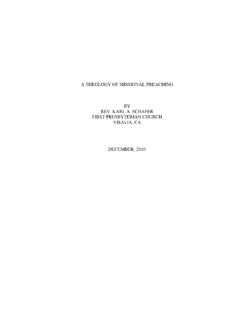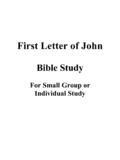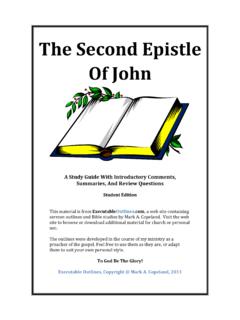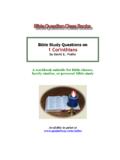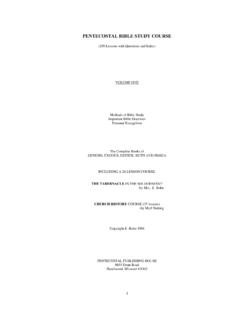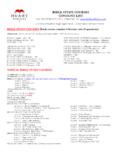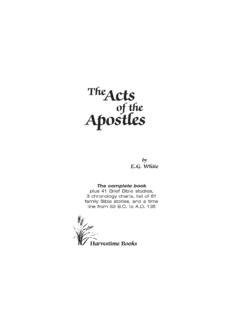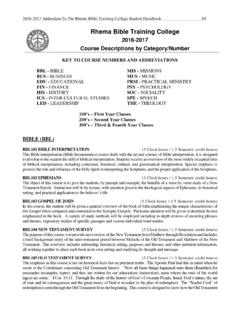Transcription of The Apostle John’s Spiritual Foresight: Interpretation ...
1 1 The Apostle john s Spiritual foresight : Interpretation through the Exegesis of Revelation Daryl D. Green Regent University Abstract The paper explores how strategic foresight led early Christian Communities, as depicted in the Apostle john s perspective in Revelation. Thus this paper will attempt to prove a futuristic application is possible from a biblical framework. Forty years ago, people would consider a futurist synonymous to a fortune teller, seer, or mystic. In analyzing the text of Chapter 14:1-5, this essay uses Ideological Texture Analysis to construct the historical context in which the Revelation came to Apostle john and how he made use of these visions to pastorally lead early Christian communities under his care into the future. This effort will contribute to further exploration into the application of strategic foresight to biblical texts.
2 2 How did the author of Revelation view his divine vision to the church under his guidance? Forty years ago, people would consider a futurist synonymous to a fortune teller, seer, or mystic. The purpose of this paper is to explore how strategic foresight led early Christian Communities, as depicted in the Apostle john s perspective in Revelation. Thus this paper will attempt to prove a futuristic application is possible from a biblical framework. In analyzing the text of Chapter 14:1-5, this essay uses Ideological Texture Analysis to construct the historical context in which the Revelation came to Apostle john and how he made use of these visions to pastorally lead early Christian communities under his care into the future. Many Christians are reluctant to study Revelation for various reasons. Some are fearful of the imageries given while others view it as too complicated.
3 Although some individuals may call john a seer, we consider him an early foresight strategist because his visions created a Spiritual transformation. Revelation is an apocalyptic writing that warns of future events. However, the overall meaning of the text is hidden from the casual reader (Krejcir, 2007). Schwartz (2000) argues that the current focus of Christians has moved from God-confidence to self-confidence. In point of fact, many organizations can benefit from a spirit-filled leader. Being called a Son of Thunder, john brought to the church a sense of urgency. john , a former fisherman from Capernaum, was the son of Zebedee and brother of James (COGwriter, 2006). He was also a part of Jesus inner circle. Indeed, john had a prominent leadership position in the apostolic body. An ideological study requires that individuals understand the nature of the writer, rather than the writing.
4 In fact, ideological analysis evaluates the bias, opinions, and preferences of a specific writer along with specific interpretations (Robbins, 2006). john wrote the Book of Revelation which is also 3 called the Apocalypse. In doing so, john addressed the seven churches in Asia Minor. It was under this suffering that Jesus gave john these visions. With this thought in mind, we will focus ideologically on the evaluation of this passage from a historical, idealistic, and futuristic approach. Historical Perspective In this biblical perspective, eschatology can only be understood from the historical, religious perspective. Therefore, an investigation must focus forward from the first century instead of backwards from the 21st century (Krejcir, 2007). Emperor Domitian exiled the aged john to Patmos, a place the Roman Empire reserved for many political and religious figures.
5 In fact, it was john s zealot-like attitude toward Christianity that most troubled the Romans ( , ). Banishing the old man to the forsaken island of Patmos would certainly silence him. It did not. Matter of fact, john continued to defy the Roman magistrate s order to spread the gospel. The Christian community waited for Jesus return with anticipation in hopes of returning to its prominence as a powerful nation. Rome was a dominant political figure in almost every fa ade of their Jewish living (White, 2007). The imposition of Roman power engulfed any Jewish political structure. Rome controlled the world. In this framework, the best Roman minds were absorbed into politics, war, and economics with little time for intense religion or philosophy (White, 2007). Historically, one can understand john s enthusiasm of the visions in Revelation and how driving forces of change was influencing his outlook.
6 This Roman control left a bitter taste in the Jewish mouth. In Revelation, 14:1-5, john s vision places him in a heavenly scene. There is the Lamb of God with his loyal follower, highlighted by the 4 Almighty God in His glory. The actors include the Lamb, 144,000 witnesses, God on His throne, four Living Beings, and twenty-four elders. The Lamb represents Jesus Christ as the sacrificial Lamb of God and Mount Zion represents the Temple; these symbols were familiar to Jewish tradition. In providing this scenario, john witnesses God s majesty and power. Ideologically speaking, john evaluated these visions with a Jewish perspective. The 144,000 beings carried this mark on their forehead. Clark, a theologian, argues that these men openly showcase this mark. However, these markings are not abnormal. Many direct religions during john s time period wore marks of their gods.
7 In fact, Krejcir (2007) argues that john saw things to come. Given this premise, the Apostle john uses his past historical understandings of his revelation in this text to provide a sense of hope during this persecution. Idealistic Perspective In this framework, the Revelation text is merely symbols. The prophecies of the Apocalypse are not future happenings. Instead, it promotes that the principles of Christian warfare with Satan will repeat itself until the Second Coming (Krejcir, 2007). Reviewing the 144,000 believers, an idealist would conclude this number represents those individuals who have survived tribulation are symbolic, not literally. Mounce maintains that the 144,000 people are difficult to determine from the text. He argues that the identity of the 144,000 appears to relate to a group of super saints (Mounce, 1997).
8 Yet, an idealist approach such as Carrington views, this number figuratively meaning those individuals who have kept themselves from adultery and fornication (Mounce, 1997). Given this premise, the Apostle john uses a symbolic approach of dealing with the issues of that timeframe. 5 Future Perspective In the futurist view, this text provides the reader with the details and order of future events preceding the Second Coming. Furthermore, it assumes that none of the events in 70 AD or what Jesus outlined in Matthew 24 had happened or had any bearing on the prophecies of the Apocalypse (Krejcir, 2007). In fact, scholars from the futurist view presume eschatology is more important than futurology. Futurology is the study of the future while eschatology relates to the study of the end of the world or the humankind.
9 While the futurology provides a secular framework scientifically, eschatology seeks answers on a Spiritual plane (Peters, 2005). In many people s mind, foresight is more like a Las Vegas gambling expedition. An individual may get lucky and get it right or lose everything. According to futurist Slaughter (2005), foresight allowed humans to weigh different courses of action and to invest possible futures on every level in order to make better decisions. In the case of this text, foresight provides an early warning system to humanity to avoid possible dangers. In analyzing Revelation 14:1-5, a futurist would gather from john , a forecast for the future. LaHaye (1999) argued that this scene establishes the beginning of an apostate church similar to the National Council of Churches today in that it does not take positions on evil, secularism, or immorality.
10 Furthermore, Krejcir (2007) maintained that the Apostle john was writing to encourage and chastise those pastors from the seven churches. He warned the early Christians not to worship the Emperor or comply with evil, apathy, or compromise. Through his experience, the Apostle john had learned to stimulate values for future Christian living during the time of hardship. Through past prophets, angelic hosts, the Lamb of God, and diver signs, God equipped the Apostle john with futuristic tools for 6 this era. We must consider that john s understanding was also limited by his time period. Clearly, a beast in his vision could easily have been his description of a 21st century airplane. However, it is clear that john was able to guide the early church with his divine visions. john saw the early warning signs of problems to come.


